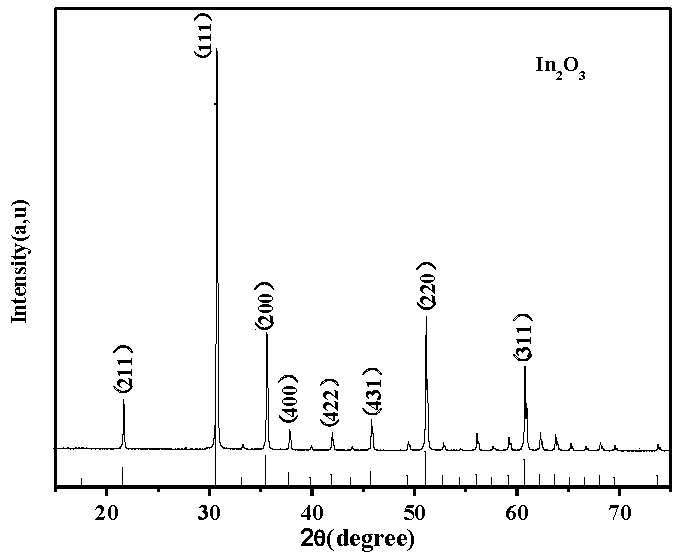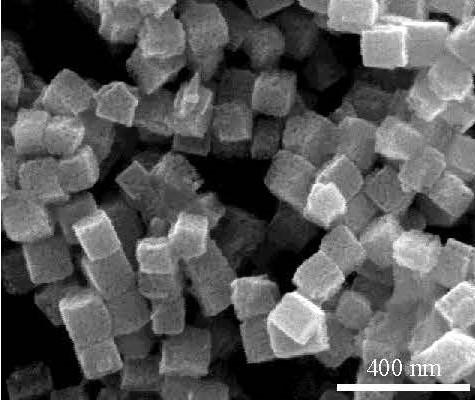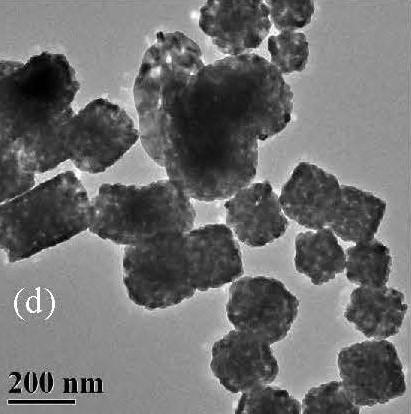Preparation method of RuO2-In2O3 nano composite material
A nanocomposite material, ruo2-in2o3 technology, used in nanotechnology, nanotechnology, analytical materials, etc.
- Summary
- Abstract
- Description
- Claims
- Application Information
AI Technical Summary
Problems solved by technology
Method used
Image
Examples
Embodiment 1
[0017] (1) Weigh a certain amount of indium chloride, trisodium citrate and urea and dissolve them in absolute ethanol, in which the concentration of indium chloride is 0.020 mol / L, the concentration of trisodium citrate is 0.120 mol / L, and the concentration of urea The concentration is 0.099 mol / L. And control the mol ratio of indium chloride and trisodium citrate to be 1:6;
[0018] (2) Move the mixed solution obtained in step (1) to a hydrothermal reaction kettle lined with polytetrafluoroethylene, conduct a hydrothermal reaction at 140 °C for 4 h, and then use the product after the hydrothermal reaction The centrifuge was used for solid-liquid separation, and the obtained solid product was washed with deionized water and ethanol several times. The obtained solid product was placed in a drying oven, dried at 60 ° C, and then placed in an alumina crucible and placed in a muffle furnace. Heat treatment at ℃ for 3 h to obtain indium oxide powder;
[0019] (3) Disperse the in...
Embodiment 2
[0022] (1) Weigh a certain amount of indium chloride, trisodium citrate and urea and dissolve them in absolute ethanol, in which the concentration of indium chloride is 0.020 mol / L, the concentration of trisodium citrate is 0.100 mol / L, and the concentration of urea The concentration is 0.099 mol / L. And control the mol ratio of indium chloride and trisodium citrate to be 1:5;
[0023] (2) Move the mixed solution obtained in step (1) to a hydrothermal reaction kettle lined with polytetrafluoroethylene, conduct a hydrothermal reaction at 140 °C for 2 h, and then use the product after the hydrothermal reaction The centrifuge was used for solid-liquid separation, and the obtained solid product was washed with deionized water and ethanol several times. The obtained solid product was placed in a drying oven, dried at 60 ° C, and then placed in an alumina crucible and placed in a muffle furnace. Heat treatment at ℃ for 3 h to obtain indium oxide powder;
[0024] (3) Disperse the in...
Embodiment 3
[0027] (1) Weigh a certain amount of indium chloride, trisodium citrate and urea and dissolve them in absolute ethanol, in which the concentration of indium chloride is 0.020 mol / L, the concentration of trisodium citrate is 0.080 mol / L, and the concentration of urea The concentration is 0.099 mol / L. And control the mol ratio of indium chloride and trisodium citrate to be 1:4;
[0028] (2) Move the mixed solution obtained in step (1) to a hydrothermal reaction kettle lined with polytetrafluoroethylene, conduct a hydrothermal reaction at 120 °C for 4 h, and then use the product after the hydrothermal reaction The solid-liquid separation was carried out in a centrifuge, and the obtained solid product was washed several times with deionized water and ethanol. The obtained solid product was placed in a drying oven, dried at 60 ° C, and then placed in an alumina crucible and placed in a muffle furnace. Heat treatment at ℃ for 3 h to obtain indium oxide powder;
[0029] (3) Dispers...
PUM
 Login to View More
Login to View More Abstract
Description
Claims
Application Information
 Login to View More
Login to View More - R&D
- Intellectual Property
- Life Sciences
- Materials
- Tech Scout
- Unparalleled Data Quality
- Higher Quality Content
- 60% Fewer Hallucinations
Browse by: Latest US Patents, China's latest patents, Technical Efficacy Thesaurus, Application Domain, Technology Topic, Popular Technical Reports.
© 2025 PatSnap. All rights reserved.Legal|Privacy policy|Modern Slavery Act Transparency Statement|Sitemap|About US| Contact US: help@patsnap.com



